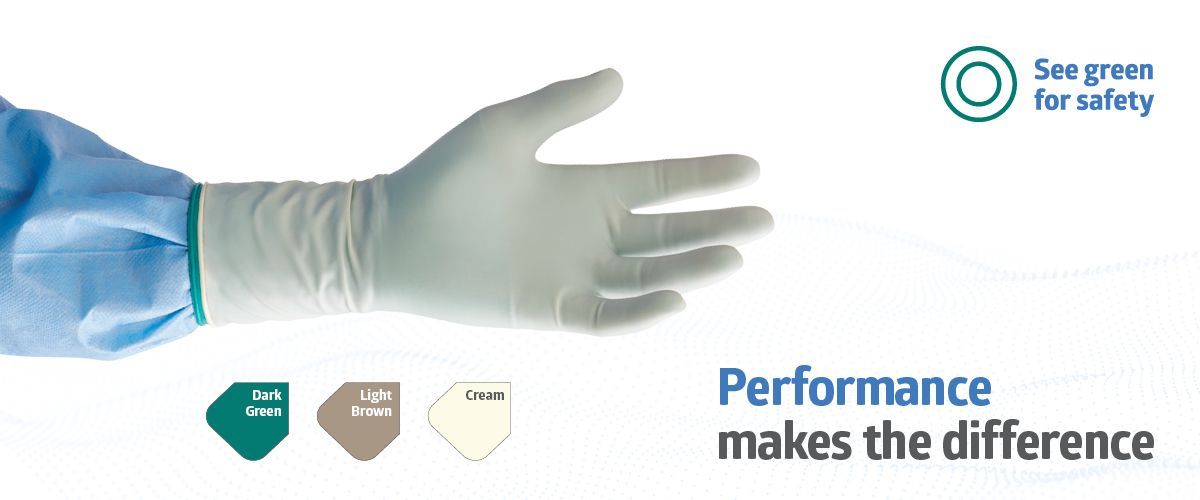Although often undetectable to the naked eye, micro perforations in a surgical glove are enough to allow pathogens to pass through, with studies showing that over 80 per cent of all surgical glove perforations go undetected until the procedure is complete1. This has significant implications in terms of both health and financial costs.
One method to reduce these risks is through double gloving. This has become a common practice in many surgical specialities such as trauma and orthopaedics, which at 78 per cent has one of the highest perforation rates in healthcare2. In specialities such as this, double gloving acts as a vital perforation detection system and provides an 87 per cent decrease in cross-contamination and potentially harmful blood-borne pathogens3.
Enhancing perforation recognition
However, even with double gloving, micro perforations in the glove are often not visible when they occur, leaving healthcare workers unaware that the protective barrier has been compromised. A further way to enhance safety is by using a darker coloured under-glove with a lighter coloured top glove. This improves perforation recognition by four times vs. using just a single glove4, and creates an additional safety barrier to prevent cross-contamination should the outer glove become compromised through an unnoticed sharps injury.
Medline’s ‘See Green for Safety’ range
Medline’s offers a ‘See Green for Safety’ range of green under-gloves that are available in three materials; latex, neoprene and polyisoprene (PI). Through our double gloving system, should fluid leak into the space between the green-coloured under-glove and the lighter-coloured top-glove, there will be a distinct ‘glow’ which alerts the wearer that a perforation has occurred in that area and that the glove needs to be replaced.
As an added benefit, our Signature™ Latex Green and SensiCare® PI Green under-gloves include an inner coating of 100 per cent freeze-dried aloe vera to help soothe and moisturise the skin. This coating is dissolved from the natural heat of your hands during the procedure and coats the skin, reducing trans epidermal water loss and maintaining the water content of the stratum corneum.
For wearers with a known sensitivity to chemical accelerators, our DermAssure™ Green provides a 100 per cent accelerator-free and latex-free glove that can be used as either an under-glove or top glove.
Interested in trying out our SensiCare® gloves?
Order a free SensiCare® kit containing samples of our SensiCare® PI Micro latex-free gloves and SensiCare® PI Green under-gloves and tell us what you think. Click here to go to the form.


Aled Jones
Product Manager, Medline Industries Ltd.
Aled has an MSc in Exercise Physiology and over nine years experience working as a Product Manager within the healthcare industry. He is responsible for managing Medline’s surgical and examination gloves, O.R. and PPE portfolios for the UK and Ireland.
Over his three years at Medline, Aled has led the successful development of SensiCare®, DermAssure™ and Signature ranges of surgical gloves. At local level he works closely with theatre teams and procurement along with Medline teams to ensure trials are run efficiently and without disruption to customers’ day-to-day activities.
References
1. Edlich, R.F., Wind, T.C., Hill, L.G., Thacker, J.G. Resistance of double-glove hole puncture indication systems to surgical needle puncture. J Long Term Eff Med Implants. 2003;13: 85–90
2. Akhter, P., Akram, M., Malik, A., Loona, V., & Rashid, A. The incidence & pattern of micro perfoiration of surgical gloves after single use. University Journal of Dental Sciences, (2020), 6-9.
3. Berguer, R and Heller, PJ. “Preventing Sharps Injuries in the Operating Room.” Journal of the American College of Surgeons. 2004; (199)3:462-467.
4. Lee, S. Y. What Role Does a Colored Under Glove Have in Detecting Glove Perforation in Foot and Ankle Procedures? Clinical Orthopaedics and Related Research, (2022). 2327-2334.

